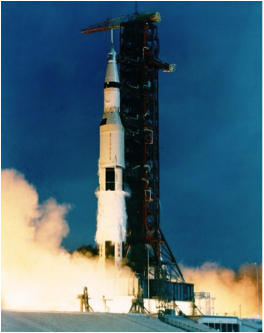 “We choose to go to the moon in this decade and do the other things, not because they are easy, but because they are hard,” said President John F. Kennedy during his famous speech at Rice University in 1962. Seven years later, on July 16, 1969, three brave astronauts, Neil Armstrong, Buzz Aldrin and Michael Collins sat atop a massive Saturn V rocket, waiting to launch for the moon. President Kennedy’s challenge was being fulfilled before the close of the decade.
“We choose to go to the moon in this decade and do the other things, not because they are easy, but because they are hard,” said President John F. Kennedy during his famous speech at Rice University in 1962. Seven years later, on July 16, 1969, three brave astronauts, Neil Armstrong, Buzz Aldrin and Michael Collins sat atop a massive Saturn V rocket, waiting to launch for the moon. President Kennedy’s challenge was being fulfilled before the close of the decade.
This year marks the 45th anniversary of the Apollo 11 launch and moon landing, a pivotal milestone for America and the world. Apollo 11 proved that man could reach beyond the Earth and that in the “Space Race” with Russia, the United States had taken the lead. When Russia launched the first man into space, Yuri Gagarin in 1961, America had seemed one step behind, launching Alan Shepherd into space a month later. The Apollo 11 moon landing finally sealed America’s status as the world’s space exploration leader.
 Four days after Apollo 11 launched, Armstrong and Aldrin boarded the lunar module, Eagle, and Collins stayed in the Columbia command module orbiting the moon. As Eagle began its descent to the moon’s surface, Armstrong and Aldrin saw that the planned landing area was full of boulders. Armstrong made the decision to ignore the script and manually pilot the Eagle to a clearer landing space. At exactly 4:18 p.m. EDT on July 20, 1969, the Eagle landed on the moon. Americans watched on their televisions in awe as Armstrong became the first human to leave footprints on the moon.
Four days after Apollo 11 launched, Armstrong and Aldrin boarded the lunar module, Eagle, and Collins stayed in the Columbia command module orbiting the moon. As Eagle began its descent to the moon’s surface, Armstrong and Aldrin saw that the planned landing area was full of boulders. Armstrong made the decision to ignore the script and manually pilot the Eagle to a clearer landing space. At exactly 4:18 p.m. EDT on July 20, 1969, the Eagle landed on the moon. Americans watched on their televisions in awe as Armstrong became the first human to leave footprints on the moon.
Aldrin described the lunar surface as “magnificent desolation” and the two astronauts spent two hours photographing and collecting samples. Before leaving, they planted an American flag in the soil, along with a patch honoring the fallen Apollo 1 crew, and a plaque reading, “Here men from the planet Earth first set foot upon the moon. July 1969 A.D. We came in peace for all mankind.”
Kennedy Space Center Visitor Complex honors the Apollo program at the Apollo/Saturn V Center. Visitors can get an up close look at the monstrous 363-foot-long Saturn V moon rocket, the most powerful rocket ever built and one of only three Saturn V rockets in existence. Visitors can also see the Lunar Landing Module and many other treasures from the Apollo program, and even touch a real moon rock.
